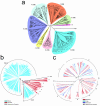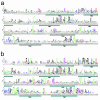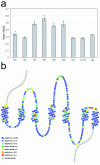The odorant receptor repertoire of teleost fish
- PMID: 16332259
- PMCID: PMC1325023
- DOI: 10.1186/1471-2164-6-173
The odorant receptor repertoire of teleost fish
Abstract
Background: Vertebrate odorant receptors comprise three types of G protein-coupled receptors: the OR, V1R and V2R receptors. The OR superfamily contains over 1,000 genes in some mammalian species, representing the largest gene superfamily in the mammalian genome.
Results: To facilitate an informed analysis of OR gene phylogeny, we identified the complete set of 143 OR genes in the zebrafish genome, as well as the OR repertoires in two pufferfish species, fugu (44 genes) and tetraodon (42 genes). Although the genomes analyzed here contain fewer genes than in mammalian species, the teleost OR genes can be grouped into a larger number of major clades, representing greater overall OR diversity in the fish.
Conclusion: Based on the phylogeny of fish and mammalian repertoires, we propose a model for OR gene evolution in which different ancestral OR genes or gene families were selectively lost or expanded in different vertebrate lineages. In addition, our calculations of the ratios of non-synonymous to synonymous codon substitutions among more recently expanding OR subgroups in zebrafish implicate residues that may be involved in odorant binding.
Figures




References
Publication types
MeSH terms
Substances
LinkOut - more resources
Full Text Sources
Molecular Biology Databases

